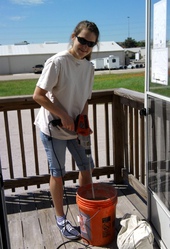Highlight
Student Team Completes Seminal Research on Zero Energy Air Purification Materials
Achievement/Results
Four graduate students who are part of the National Science Foundation’s (NSF) Integrative Graduate Education and Research Traineeship (IGERT) program in Indoor Environmental Science and Engineering at The University of Texas at Austin (UT) have embarked on a novel study of “zero energy air purification” (ZEAP) materials to reduce human exposure to indoor pollutants without an energy penalty. The research was initiated by second-year IGERT trainee Elliott Gall (Environmental Engineering) and affiliate alumnus Donna Kunkel (Environmental Engineering), whose seminal work on the subject was published in the journal Building and Environment. Gall and Kunkel focused on ozone removal to unpainted gypsum board and to activated carbon mats that are hung from walls or used as sleeves over fan blades. They paid particularly attention to the role of air mixing and relative humidity on the performance of each ZEAP, and determined fundamental parameters necessary to understand the transport of ozone to, and reactions with, ZEAPs. Gall and Kunkel also mentored two undergraduate students who helped to complete an assessment of technology application to homes in Houston, Texas. They predicted, using state-of-the-art knowledge, a health benefit/ZEAP cost ratio of 25 to 50:1 for homes in Houston, and a greater impact on human exposure to ozone than over three decades of outdoor regulatory efforts. Gall has extended his studies of ZEAPs as a continuing IGERT trainee with a focus on several green building materials, and near-surface fluid mechanics and its effects on both ozone and particle removal to ZEAP surfaces.
Over the past year, first-year IGERT trainee Erin Darling (Environmental Engineering) has continued studying several earthen-based materials (perlite-based ceiling tiles, clay wall coverings, etc.) in a large 70 m3 environmental chamber and the NSF IGERT-funded UTest House, and approximate 110 m2 test house facility. Darling is focusing on not only on ozone removal but also on speciated and total molar yields of oxidized by-products (mol of product/mol of ozone). Preliminary testing with most inorganic earthen-based materials indicate moderate to high ozone removal, relative to typical background removal rates in homes, with little by-product formation. Darling is now embarking on a closer analysis of the chemistry of ozone removal at ZEAP surfaces and how it can be enhanced through slight material modifications.
Second-year affiliate Clément Cros (Environmental Engineering) has been studying the long-term viability of activated carbon mat and several green building materials in actual field locations. He has placed four such materials in five field locations for a six month period. On a monthly basis the materials are brought back to the laboratory and tested for their reactivity with ozone and any changes in by-product formation. Cros also collects monthly-integrated environmental parameters ranging from temperature to relative humidity, surface dust coverage, and integrated VOCs in air near field ZEAPs. His findings are striking and indicate little to no changes in the overall performance of ZEAPs in actual buildings over at least a six month period. Activated carbon and perlite-based ceiling tile were observed to be the best ZEAPs of those tested in terms of ozone removal and low by-product emissions. Cros is now extending his research to removal of volatile organic compounds by sorptive interactions and in-situation regeneration using solar energy.
In addition to a paper in Building and Environment, it is expected that Gall and Cros will each be lead authors on journal papers that are submitted for review by the end of May, 2010. In the past year they each presented their findings as conference papers at Healthy Buildings 2009, a major international conference in the indoor air field.
IGERT faculty participants are also working to promote the ZEAP concept in the U.S. and elsewhere. Richard Corsi presented described ZEAPs and preliminary findings at meetings/symposia in Kentucky, Denmark, Sweden, and Bulgaria, the latter being to 42 Ph.D. students from Eastern European countries. IGERT faculty participant Jeffrey Siegel gave a presentation to graduate Interior Design students at the Parsons School in New York City, and the faculty there made into a cornerstone of their course this semester; the students had to integrate ZEAPs into their interior designs. This is an example of IGERT initiated cross-institution, interdisciplinary collaboration.
The novel work that IGERT students have been doing on ZEAPs is interesting other students. First-year IGERT trainee Lindsay Graham (Psychology) has expressed a strong interest in working with the ZEAP team on the psychological profiles of occupants who use ZEAPs and report changes in their indoor environments. This connection would not have occurred without the framework of an interdisciplinary IGERT community.
Address Goals
While past research has been completed on the removal of ozone to indoor materials, our studies are the first to systematically explore and document the potential for the strategic use of selective materials for lowering population exposures to ozone while reducing background levels of potentially harmful by-products that are formed when ozone reacts with common indoor surfaces. Our IGERT students are performing seminal research on this important topic. They are the first researchers to calculate the extent to which this strategy can reduce ozone exposures, and also the first to explore the importance of strategic placement of ZEAPs in areas that are already characterized by elevated indoor air speeds. They are now extending their research to better understanding the most important processes that affect pollutant removal to ZEAPs in order to facilitate optimization of ZEAP materials, and are also beginning to pursue application of ZEAPs to a wider range of pollutants, including VOCs and particulate matter. All of these findings and contributions relate to the goal of discovery. Furthermore, four IGERT graduate students and one undergraduate student whom they have mentored have engaged in learning related to laboratory and field experimental methods, engineering analysis, surface chemistry, and fluid mechanics.







